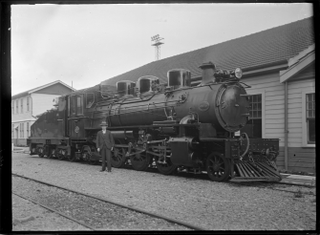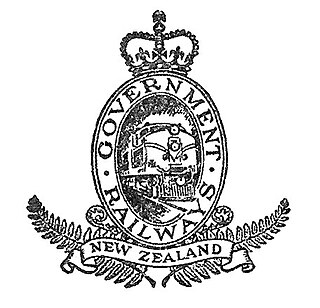
The Ferrymead Railway is a New Zealand heritage railway built upon the track formation of New Zealand's first public railway, from Ferrymead to Christchurch, which opened on 1 December 1863. On the opening of the line to Lyttelton on 9 December 1867, the Ferrymead Railway became the Ferrymead Branch and was closed shortly thereafter. In 1964, rail enthusiasts began relaying track on the historic formation and the new 3 ft 6 in narrow gauge. Ferrymead Railway officially reopened in 1977. It now operates steam, diesel and electric trains regularly and is recognised as one of the most significant rail preservation sites in New Zealand.

Railway preservation in New Zealand is the preservation of historically significant facets of New Zealand's rail transport history. The earliest recorded preservation attempt took place in 1925, although the movement itself did not start properly until 1960.

Darfield is a town in the Selwyn District of the South Island of New Zealand. It is 35 kilometres west of Christchurch. Its population is 3,150 as of June 2023.
The Canterbury Railway Society is an organisation of railway enthusiasts based in the Canterbury region of New Zealand's South Island, best known for their operation of The Ferrymead Railway at the Ferrymead Heritage Park.

The New Zealand F class was the first important class of steam locomotive built to operate on New Zealand's railway network after the national gauge of 3 ft 6 in was adopted. The first locomotives built for the new gauge railways were two E class double Fairlies for the Dunedin and Port Chalmers Railway Company. The F class was the first class ordered by the central government, and between 1872 and 1888, a total of eighty-eight members of the class were constructed.
The Taonui Branch was a minor branch line railway in New Zealand's national network. Located in the Manawatū District of the North Island, it opened in 1879 and operated until 1895.
Locomotives of New Zealand is a complete list of all locomotive classes that operate or have operated in New Zealand's railway network. It does not include locomotives used on bush tramways.

The Wellington and Manawatu Railway Trust is a charitable trust based in Wellington, New Zealand, and is actively restoring former Wellington and Manawatu Railway locomotive No.9, to full working order.

The NZR C class consisted of twenty-four steam locomotives built to perform shunting duties on New Zealand's national rail network. It is sometimes known as the big C class to differentiate it from the C class of 1873.

The New Zealand Railways Department, NZR or NZGR and often known as the "Railways", was a government department charged with owning and maintaining New Zealand's railway infrastructure and operating the railway system. The Department was created in 1880 and was corporatised on 1 April 1982 into the New Zealand Railways Corporation. Originally, railway construction and operation took place under the auspices of the former provincial governments and some private railways, before all of the provincial operations came under the central Public Works Department. The role of operating the rail network was subsequently separated from that of the network's construction. From 1895 to 1993 there was a responsible Minister, the Minister of Railways. He was often also the Minister of Public Works.

The Glenbrook Vintage Railway (GVR) is a heritage steam railway in Glenbrook, New Zealand.

The NZR JA class was a class of fifty-one 4-8-2 steam locomotives operated by the New Zealand Railways Department (NZR). The locomotives were built in two batches; the first batch was constructed in-home at the Hillside Workshops at Dunedin between 1946 and 1956, while the second batch was produced by the North British Locomotive Company (NBL) of Glasgow, Scotland in 1951. To differentiate between the two batches, the locomotives were identified by their builder.

The NZR WF class were steam locomotives designed, built and used by New Zealand Railways (NZR). Their wheel arrangement is described by the Whyte notation 2-6-4T and the first members of the class entered service in 1904. The locomotives were tank engines designed by the Railways Department's Chief Mechanical Engineer A. L. Beattie, and were mainly built for suburban duties such as those between Christchurch and Lyttelton. They also saw main-line service in the Taranaki region, but most of the class members were assigned to branch line and local services throughout the country. Two were experimentally converted to oil burners in 1909-1910. The tests were satisfactory, but as coal was much cheaper than oil at the time, no further conversions took place.

The Whitecliffs Branch was an 18.4 kilometres (11.4 mi) long branch line railway that formed part of New Zealand's national rail network in the Canterbury region of the South Island. It was more industrial than the many rural branches on the South Island's east coast whose traffic primarily derived from agriculture, and it operated from 1875 until 1962.

Glentunnel is a village located in the Selwyn District of the Canterbury region of New Zealand's South Island.
Rail transport in Christchurch, the largest city on New Zealand's South Island, consists of two main trunk railway lines intersecting in the suburb of Addington, carrying mainly long-haul freight traffic but also two long distance tourist-oriented passenger trains. The two lines are the Main North Line and Main South Line, collectively but unofficially known as the South Island Main Trunk Railway. There is a heritage line at the Ferrymead Historic Park that is operated with steam, electric, and diesel motive power hauling tourist-oriented services.

A & G Price Limited is an engineering firm and locomotive manufacturer in Thames, New Zealand founded in 1868.
The Ohai Railway Board (ORB) was a short railway in Southland, New Zealand. The railway line itself still exists as the Ohai branch line, but the ORB was dissolved in 1990, and in 1992 the Southland District Council sold the board's assets to New Zealand Rail Limited.

Homebush is a settlement in the Canterbury region of New Zealand. It has had a long association with the pioneering Deans family.
















